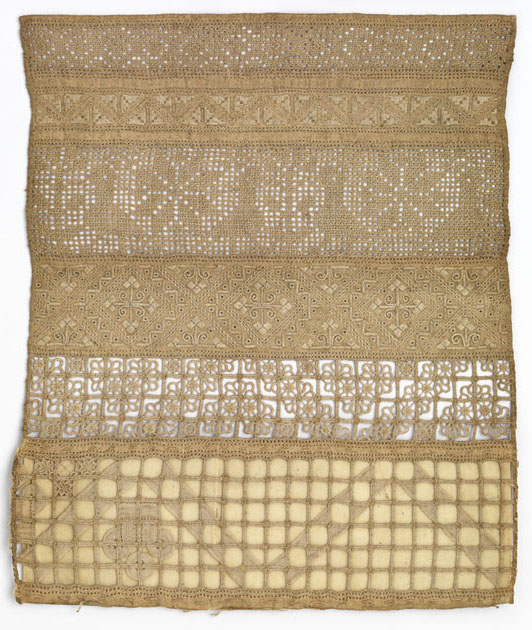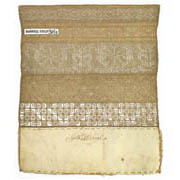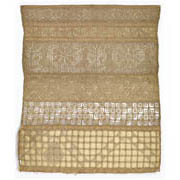Details
- Object type
sampler; band sampler
- Place Associated
England (place of manufacture)
- Date
circa 1640-1670
- Materials
linen, linen, silk, hand-stitched
- Dimensions
overall: 254 mm x 228 mm
- Description
-
Sampler with whitework in linen (32 threads per cm, 80 threads per inch), top and sides turned over and hemmed, embroidered in white silk and linen thread worked in eyelet, double-running and block satin stitch, and cut and drawn thread work with reticella needle lace worked in buttonhole, dove’s eye, overcast and woven wheel stitch with needlework woven bars and buttonhole bar fillings, with six bands of border patterns separated by rows of Italian hem stitch. Bottom band unfinished and backed with the parchment on the reverse with handwritten in black ink 'Judith Ffisher'.
The long, narrow shape of this sampler is typical of the 1600s and is called a ‘band sampler’. The linen was often cut horizontally from the end of a long length of material, leaving the selvage visible at both ends. It was then embroidered with rows of floral and geometric border patterns in brightly coloured silk threads or in cut and drawn work with needle lace fillings. After completing her sampler, a young girl would progress to making small needlework panels, often illustrating biblical or classical scenes. Some of these she may have sent to a local cabinetmaker to be made up into an embroidered box or casket. Inside would be stored sewing equipment, including the band sampler carefully rolled up, and treasured keepsakes, sometimes hidden in secret compartments.
Girls who had mastered more complex embroidery stitches on their coloured silk samplers went on to make whitework samplers such as this charming example. White work requires not only advanced needlework skills, but also extremely good eyesight to work with the fine white threads against a white background. This is generally regarded as one of the most difficult forms of needlework, with the most admired being the exquisitely embroidered Ayrshire white work infants’ gowns of the mid-1800s. The last row is still unfinished and shows the various stages of development. Still attached is the backing paper used to support the grid while it was worked, inscribed with the maker’s name. The majority of these white work samplers are anonymous, and it is ironic that by leaving her piece unfinished Judith created a lasting name for herself.
Several of the band patterns in whitework techniques are found on other samplers, including one by Martha Edlin, 1669 (now in the Victoria and Albert Museum, London, T.434-1990). A couple of the band patterns are similar to patterns in Nicholas Bassee, New Modelbuch, 1568, such as plate 28 lozenge designs for satin stitch and plate 44 bird pattern for cut work.
Provenance: Purchased by William Burrell before 1934.
- Credit Line/Donor
Gifted by Sir William and Lady Burrell to the City of Glasgow, 1944
- Collection
Burrell Collection: Needlework Samplers
- ID Number
31.13
- Location
In storage


